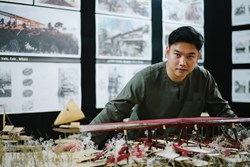House for a man alone
This essay by Michael David was highly commended in the open category winner of the 2018 Warren Trust Awards for Architectural Writing.
Wellington architect Michael Davis crafted an essay about a house that lives only in his mind and memory.
It is a house for a man alone.
I designed it, but it has been altered many times over the years. Unfortunately I don’t visit it as often as I used to. I’ll admit that it is quite eclectic for, while I am essentially a modernist, I am also a keen student of the richness of influences like Robert Venturi’s Complexity and Contradiction in Architecture. The house is located on the Kāpiti Coast, with a view of the sea but not so close as to get saltwater-beaten. As you approach – usually by car – there is an initial glimpse of the house through some poplar trees. It reappears as the driveway leads to the base of a ramped bridge to the house. I like the way that the crunch of gravel signals the arrival of a visitor.
I show my age when I admit that the ramped entry was inspired by the elevated walkways of John Scott at the late Aniwaniwa Visitor Centre, where the handrail is topped with smooth timber poles – good to lean on while you chat with arriving or departing visitors.
The form of the house is a simple pyramidal roof sitting atop a single storey on the sloping site. There are some projections – “saddle bags” as Charles Moore would call them. I recently reread Moore’s The Place of Houses, still one of the best books written on house design. The wider-than-usual vertical shiplap cladding was inspired by Moore’s work at the Sea Ranch on the California coast. It’s silvered off now, sitting comfortably in the natural surroundings.
The front door has the attention to craft that Bill Alington introduced me to in my last year at university when we talked about a project for an entry that he had designed as a student. The door pull is carved and where you place your hand is driftwood smooth. There is a rust-coloured cast-iron door knocker in the shape of a hand; it’s old, and came from a market in Barcelona. The lever door handles throughout the rest of the house are copies of one I recovered from a demolished building in the 1980s. The original still sits in a drawer next to me and it so comfortably fits my hand that I cannot imagine anything better to open a door with.
We enter and on the left is my study – the most important room. I once worked for someone who had an octagonal shaped room lined with books and this space mimics that effect. Encircled by my best friends, it is a room that both calms my soul and inspires me. I particularly like the reassuring acoustic of all the books. The desk is loosely based on a timber study carrel from Louis Kahn’s Phillips Exeter Academy Library and, like that building, there is a warming fireplace with a raised-brick hearth large enough to sit on.
Further on, there is the living room. The boat hull is a frequently referenced analogy for basic shelter, and so in this barrel-vaulted space there are exposed timber rafters and honey-coloured sarking coming down to painted walls. The deep ochre colour comes from the Dulwich Art Gallery and compresses the room, as well as being an enhancing background for the etchings I have a fondness for.
On the north-west face there is a bay window with a long squab seat; it is well over a metre wide so there is room to stretch out, have a laptop or magazine beside you, but, most importantly, to enjoy the sun on a cool day. The kitchen is easily described. It’s all about efficiency and cleanliness – lots of stainless steel, and racks, and equipment on display. I am by nature an untidy person so I’m adamant that everything has its place. This includes a sconce where my wine glass can be found when I cook. Importantly, though, the kitchen is enclosed; it’s not one of those modern open-plan kitchens. For me, cooking is not a performance art. I like to create and make mess, noise and odours away from others.
Nearby is the dining room. This is important, as dinner parties are my preferred form of social engagement. I love candlelight and its primitive appeal; it always brings out the storyteller in us.
What was the inspiration for this space? Sir John Soane’s Museum in London has always been something of a place of pilgrimage for me, but I got a particular insight when once I went to an evening opening when the house was presented in its original candlelit state. So I pay homage to this architectural master by referencing the breakfast parlour with a gently curved canopy ceiling, concealed perimeter lighting and a series of small ceiling-mounted mirrors that catch and reflect the candlelight. The pale yellow colour of the original was recently repainted a pale blue after a visit to Christ Church at Raukokore on the East Cape.
The bathroom is a bathing room. Bathing is a much more soothing and restoring word than bath. Anyway, there is no bath. The shower is circular because that’s the way we move and because straight lines are unkind to the fluidity of water. Ritual is important to bathing and so the basin is font-like stone with a single unpolished brass tongue from which the water pours. The wall tiles are a combination of hygienic white and watery cobalt blue, although I prefer to call it Iznik blue because it was inspired by one of the traditional colours of Anatolian pottery. I was moved by this blue when I visited Leighton House Museum in London – it is a colour to cry for. The space is lit from above by an oversized circular skylight because I want to feel as if I’m outside, and because there can be no limit to light – especially sunlight – and heat in a bathing room.
Now the bedroom. It is critical that this is symmetrical for, when I am not a man alone, my partner must be my equal in this room more than any other. Serenity and a feeling of security are also important. In Heavenly Mansions: An Interpretation of Gothic the English architectural historian John Summerson reminds us that one of our earliest experiences of shelter is to go under a table and claim it as a house. The Latin word for a building is aedes, and the word for a little building is aedicula. This idea is what this bedroom is about: a small house sheltered within a larger one. And so the calmness of a simple cream-coloured aedicule form, a little like that in Philip Johnson’s Brick House, combines references to the table and to a four-posted bed.
To give privacy to the wardrobe, there is a recently added perforated timber screen. The pattern was too fine to be carved but was cut by a computer using a scan of a photo I took over 30 years ago. It is of a silhouette of a young slender woman – my travelling companion – standing in front of an intricately carved stone screen in Miriam’s House in the abandoned town of Fatehpur Sikri in northern India. I have even left the outline of the young woman in the screen as it captures a special moment in a happy youthful time.
Finally, there is what I call the “attic of memories and unfinished projects”. There is a steep ladder stairway to get up here, for there must be effort made to access these prizes and mementos. It is all timber-lined and the rafters radiate out from the centre. This aesthetic came from houses I saw in Bali where I was struck by the realisation that, although this solution was perhaps structurally less efficient, it was much more beautiful than what we in the West might do. There is one small window giving a glimpse to the ocean in the distance, what Christopher Alexander in A Pattern Language calls the “zen view”. So this space is not just for storage; it is a place of reflection and of grounding myself in the history of the items around me.
And so why is this the best building I’ve been to? It is because it is the one that I visit and revisit in my mind. This fiction may be a subversion of the question posed but this house is an evolving assembly of inspiration from the best ideas and experiences that have resonated with me over the years: parts of buildings seen, visited and salvaged; material copied from books, magazines and websites; and the influences of great teachers, mentors and colleagues – most recently a photo of the Kahn Library in an email from an architect friend. All these, together with the occasional original thought, are then moulded to suit my particular preferences.
My thoughts on this house, despite its ephemeral quality, are very sustaining. As all good architecture should, it raises my spirits.
Read this essay and nine others in 10 Stories: Writing About Architecture / 4 available for $15 + postage in the NZIA shop.



